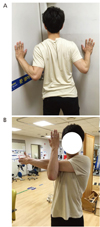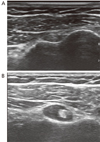Diagnosis and non-operative treatment of shoulder pain
Article information
Abstract
The shoulder is the third most common region in which musculoskeletal pain occurs, involving symptoms that cause a decrease in quality of life and a reduced ability to perform activities of daily life if untreated. Many lesions cause shoulder pain; therefore, we included those commonly encountered in primary care clinics. We aimed to describe the diagnosis and non-operative or conservative treatment modalities of rotator cuff tendinopathy, impingement syndrome, rotator cuff tear, adhesive capsulitis, biceps tendonitis, and acromioclavicular arthritis. Exercise has been reported to be effective for the treatment of impingement syndrome, and the effect of exercise has been shown to reduce pain. Both home-based self-exercise and exercise supervised by professionals are equally effective. Types of exercise should include stretching, active, active-assistive, and resistive exercise. Ten repetitions per set for 3 sets of each exercise should be prescribed initially post-injury. Repetition and resistance should be increased as strength grows. The use of ultrasonography for the diagnosis of shoulder pain has increased recently. Corticosteroid injection under ultrasonographic guidance is effective in reducing pain.
Acknowledgement
Special thanks to Sang Yoon Lee, MD, PhD and Jung Woo Kim, MD (Seoul National University Boramae Medical Center, Depart-ment of Physical Medicine & Rehabilitation) for the help on the photographs in the article.
Notes
No potential conflict of interest relevant to this article was reported.








